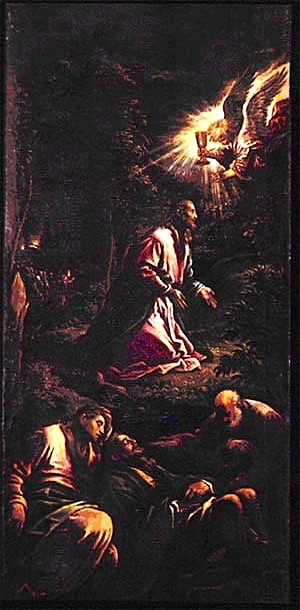 |
|
THE AGONY IN THE GARDEN
by Francesco Bassano (Italian, 1549-1592, active in Venice)
Object Research
SN 89, oil on canvas
By: Helen Gokbudak. February 29, 2000
ARTIST:
Francesco da Ponte, called Francesco Bassano, the Younger. His grandfather, Francesco
Bassano the Elder, was an artist in his native Bassano. He was the oldest of Jacopo
Bassano’s four painter sons and was trained in his father’s workshop in Bassano
between 1560-1570. His father was one of the leading Venetian artists of the 16th century.
Francesco’s precocious talent was evident in 1566-67 with the work “Miracle of
the Quails“. This work is dependent upon his father’s late more realistic style
but Francesco’s style is tighter and more controlled.
During the 1570’s, he worked with his father on large altarpieces. At this time, he
devoted himself to rustic biblical paintings. Characteristics of these paintings are color
sprinkled with light and his tendency toward more descriptive realism.
In 1579, he moved from Bassano to Venice. During the next years, he painted nocturnal
scenes illuminated by candle, torch and flare, by moonlight and divine light--nativities,
adorations of the shepherds, and passion scenes culminating in the altarpiece for Sant
Afra in Brescia. He competed with Tintoretto, Veronese and Palma Giovane and was awarded
several commissions in the Sala del Scrutinio and the Sala del Maggior Consiglio of the
Doge’s Palace.
At the height of his success, a mental illness became more acute and he threw himself
from an upper story window. He died several months later secondary to injuries from the
fall. |
SUBJECT:
The painting illustrates the text in Luke (22:41-44) “And he withdrew from them about
a stone’s throw, and knelt down and prayed, “ Father if thou art willing, remove
this cup from me; nevertheless not my will, but thine, be done.” And there appeared
to him an angel from heaven, strengthening him. And being in an agony he prayed more
earnestly; and his sweat became like great drops of blood falling down upon the
ground.”
The subject shows an angel appearing to Christ in answer to his call for divine
assistance. Christ is accepting the chalice from the hands of the angel, while below
Peter, James and John sleep unaware, and Judas approaches with the soldiers to arrest
Christ.
DISCUSSION OF THE PAINTING:
The subject of this painting was often treated by painters of the 16th century who found
it exceptionally suited to dramatic interpretation. Suida’s Catalog, 1949, titled the
painting “Christ Kneeling in the Garden of Gethsemane”; in 1976, it was
catalogued as “Christ in the Garden of Olives” and in 1996 the Groves Dictionary
of Art called it “Agony in the Garden”c. 1580.
The painting is a vertical night scene with the praying Christ in the center of the
painting and the Angel with the Chalice above Christ to the right. These two areas have
the highest luminescence, other areas of lesser light are the three disciples sleeping in
the foreground of the scene and the light appearing as a fire behind the soldiers to the
left of Christ, perceived as in the background. The folds of the reddish robe of Christ
and of the robes on the disciples and the shadows on the faces of the disciples give the
effect of light coming from above. The colors within the painting are dark except for the
luminous areas, the angel and chalice, and the shine from the helmets of the soldiers. The
figures within the painting are realistic in appearance but do not involve the viewer.
In the literature, the painting is described as a magnificent vertical composition.
Francesco Bassano pierces the darkness with rays of light issuing from the glowing chalice
to isolate the principal figures. Mysterious phosphorescence further accents the garments,
foliage and grass. This picture, inspired by the freely painted late works of Tintoretto,
in its Mannerist implications makes the transition from the Venetian High Renaissance to
ElGreco.
This painting is one of nine altarpieces showing the Passion of Christ that Francesco and
his family painted for the church of Sant’Antonio in Brescia. It hung on the left of
the choir of S.Antonio. The painting is considered as one of the greatest independent
achievements of Francesca Bassano.
HISTORICAL/SOCIAL/POLITICAL CONTEXT:
Venice is a cluster of islands at the head of the Adriatic Sea that was completely
detached from the mainland until the middle of the nineteenth century when a causeway was
constructed; it was approachable only by water. Four significant circumstances made an
impact upon the evolution of Venice: a singular setting; a vast trading empire; a
tenacious Byzantine heritage and a cohesive political and social structure with a
cosmopolitan character. (Brown)
Territorial expansion of Venice into the mainland occurred in the 15th century, these
lands were called Terraferma, including the town of Bassano, and was a source of food
supply for Venice. By the end of the 15th century, trading activities and immigration to
Venice had produced one of the most heterogeneous populations in Europe.
During the period of Counter Reformation in the 1500‘s, the Council of Trent began,
the inquisition was established, Ignatius Loyola found the Jesuit order, Michelangelo took
over the rebuilding of Saint Peters
and Philip II was the king of Spain and ruler of Netherlands, Americas, Milan, Burgundy,
Naples and Sicily.
PROVENANCE:
The Jesuit Order (S.Antonio, Brescia); Paolo Brognoli, Brescia.c.1669 and descendants to
1834;Favenza; Taton sale, Fievez, Brussels, March 10, 1927(no.3, 265x130); with
Kleinberger, Paris, 1927;acquired John Ringling.
REFERENCES:
Brown, P.F. Art and Life in Renaissance Venice. Harry N. Abrams:New York. 1997.
Pignattti, T. and Donahue, K. The Golden Century of Venetian Painting. The Los Angeles
County Museum of Art:Los Angeles. 1979.
|